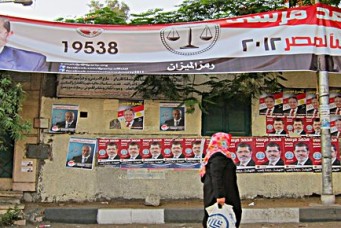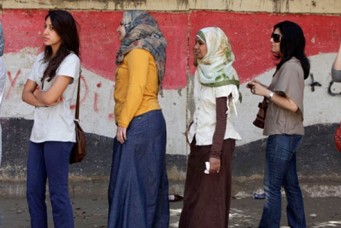A Year On, Have We Lost the Plot?
First there was Tunisia’s Jasmine Revolution, then came Libya’s bloody war, Syria’s ongoing crimes against humanity, Yemen’s forgotten struggle. And somewhere in between there was and continues to be Egypt’s so-called “revolution.”
First there was Tunisia’s Jasmine Revolution, then came Libya’s bloody war, Syria’s ongoing crimes against humanity, Yemen’s forgotten struggle. And somewhere in between there was and continues to be Egypt’s so-called “revolution.”
The closing statements by Mubarak’s lawyer in court earlier this week encapsulate the absurdity of the situation Egypt finds itself in on the first anniversary of the January 25 uprising.
Guess what you fools, Farid El-Deeb told the court and Egyptians at large, Mubarak is still the president of Egypt, he has legal immunity, so this court isn’t even fit to try him.
Ever since the trial began on August 3, with Mubarak facing charges of complicity in killing and wounding peaceful protesters during the early days of the popular uprising that eventually ousted him, the optimists have been trying to convince the pessimists that even if we didn’t achieve anything at all; even if the police, both civil and military, continue to commit gross violations of human rights; even if the economy is still on the brink of collapse; the fact that Mubarak has been removed, that the inheritance of power scenario has been buried once and for all and that the icons of his regime are behind bars facing charges of corruption and profiteering, is, in itself, a colossal achievement.
But then El-Deeb says that Mubarak is still the president. Mubarak did not formally resign, he merely gave verbal instructions to then vice president Omar Suleiman to announce that he was delegating the armed forces to “run the affairs of the nation,” which did not amount to a resignation.
In fact, El-Deeb went on to argue; since Mubarak still has immunity the court has no jurisdiction over his case. Indeed how can any court dare to put the “wounded eagle” in the dock, a man whose tribulations El-Deeb has compared to the persecution endured by none other than the Prophet Mohamed himself.
While the absurdity of his argument is at a scale that defies any reasonable response, closer inspection reveals that the wily wolf isn’t that far off the mark, at least from SCAF’s point of view. Why else hasn’t Mubarak spent a single day in jail?
So this whole year was a figment of our imagination? Mubarak is still the president of Egypt. That argument was circulated months ago and swiftly dismissed as one of El-Deeb’s legal trickeries. Apparently not. Apparently he thinks that the absurd notion is admissible in court.
I salute the presiding judge Ahmed Rifaat for not succumbing to the natural instinct to instantly hold El-Deeb in contempt of court and throw him into a jail cell for 24 hours not only for insulting him and his panel with this ludicrous assertion, but also for insulting the intelligence of 82 million Egyptians and the memory of hundreds of martyrs and thousands of wounded who’ve been led to believe that the court was going to bring them justice from the man they hold ultimately responsible.
It will come as no surprise if El-Deeb’s hypothesis also incites violence against a colluding army council that has been lying to us all along. El-Deeb stopped short of announcing that SCAF is officially still taking orders from Mubarak — if he is still the president, doesn’t that make him the Commander-in-Chief of the Armed Forces?
Weeks ago Egyptians were divided over whether to celebrate or protest on the first anniversary of the uprising. But El-Deeb has settled the dilemma for everyone.
If Mubarak is still the president of Egypt, then Jan. 25 must mark the beginning of a second uprising. One need not belong to a radical clandestine organization to reach that conclusion.
If Mubarak is still the president of Egypt, then nothing has changed. The millions who slept on the streets for 18 days to demand his ouster and the hundreds who were killed did not risk their lives only to be told that their one achievement didn’t really happen, nor to have 19 Mubaraks replace him, diligently reinforcing the brutality of Egypt’s 60-year military rule, complete with an added bonus of thousands of military trials, virginity tests and character assassinations of those who only yesterday were hailed as Egypt’s young heroes.
A year on, the future of Egypt is still engulfed in a heavy cloud of mystery and uncertainty despite the election of a new parliament.
Questions abound: How long will this PA last and on which bylaws? Will there be new legislative elections after the constituent assembly completes its task and a new constitution is approved by public referendum? What are the rules governing the assembly’s working mechanism? Will SCAF keep its promise of handing over power to civilians by the end of June? Will the Freedom and Justice Party, which won over 45 percent of seats in parliament, strike a deal with SCAF to barter immunity with authority? How far will the Brotherhood and SCAF be involved in the choice of the new president, and what will his powers be?
And that’s only on the political front. Economically, Egypt is fast-approaching an existential brick wall with foreign reserves down to $18 billion, pushing the country further towards a balance of payments crisis, analysts say.
The complete lack of vision for crisis management characterizing the performance of three consecutive cabinets has also led to a failure to deal with resounding labor demands, the most basic of which is setting a minimum and maximum wage.
But who ever said that the Jan. 25 uprising would provide an instant panacea for Egypt’s woes, accumulated over decades of bad governances, corruption, nepotism and misappropriation of public funds?
That said, does Egypt have any cause to celebrate?
There is no short answer. It will take us years to find out.
Rania Al Malky is the Chief Editor of Daily News Egypt.
This article was originally published by the Daily News Egypt:http://www.thedailynewsegypt.com/editorial/a-year-on-have-we-lost-the-plot-dp2.html



